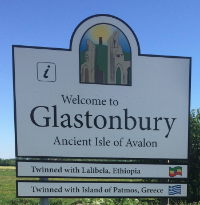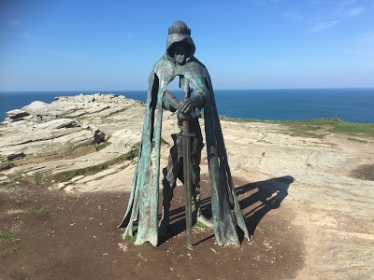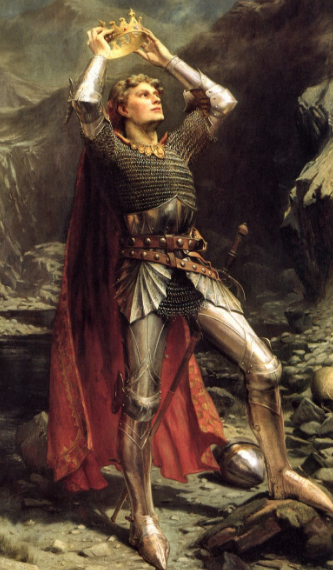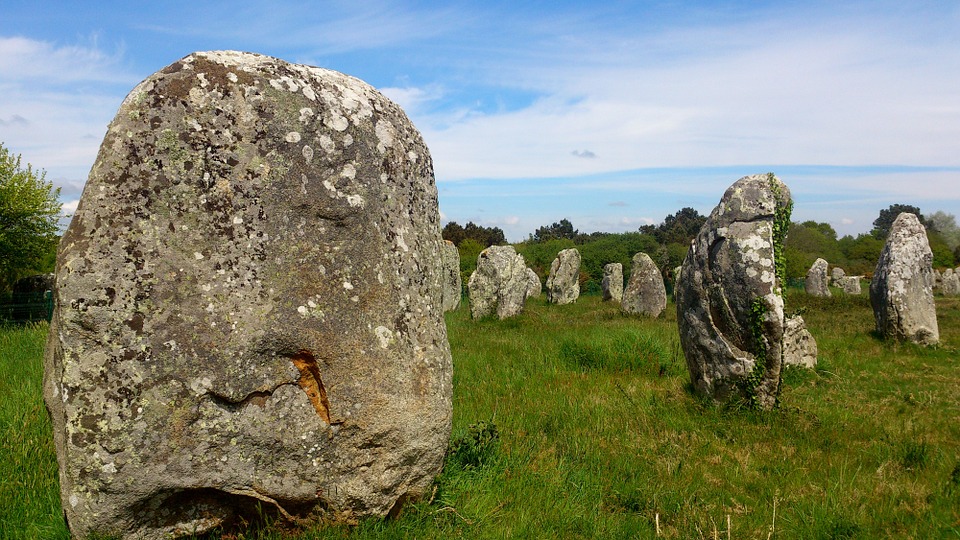If I wasn’t writing about the 17th century, I would be exploring the time of King Arthur. I’ve been drawn to the Arthurian legends for as far back as I can remember in all their variations.
Today, I have the pleasure of welcoming to the blog an author whose historical fiction novels are inspired by the old Arthurian legends. Mary Anne Yarde is the author of the Du Lac Chronicles series, which is set in the turbulent era after the death of King Arthur. Mary Anne combines my favourite elements in her novels: historical fiction with romance and adventure. Including an Arthurian backdrop is definitely icing on the cake!
Mary Anne joins us to discuss the Dark Ages, Arthur, and her upcoming release The Du Lac Prophecy which will be released August 28th. As an added treat, she’s included an excerpt of The Du Lac Prophecy.
Take it away Mary Anne!
Welcome to the Dark Ages. Welcome to the Land of King Arthur
By Mary Anne Yarde.
I have been fascinated with the life and times of King Arthur and his Knights of the Round Table since I was a child — I guess growing up a stone’s throw from Glastonbury (The Ancient Isle of Avalon) may have had something to do with that.

My book series, The Du Lac Chronicles, tells the story of what happened after the death of Arthur and continues the story of his Knights and their sons. But to write about the end of Arthur’s reign, I needed to know about the beginning. A not so easy task, it turned out.
The history of a historical Arthur is not written in stone but is, instead, engraved in folklore, and that brings its own set of challenges.
Firstly, where did Arthur come from? Well, that is an easy question to answer…
King Arthur was English. No, he was Welsh. Arthur was Scottish. He was from Brittany. Oh, for goodness’ sake, he was a Roman General!
Which is right? Arthur is so famous that everyone wants to claim him and, over the years, there have been many names thrown out there as to who he really was. But we mustn’t forget that when we are dealing with Arthur, we are digging up folklore, and that is not the same as excavating relics. We can make Arthur fit wherever we want him to, and that is where the problem lies. It is very easy to make mistakes, and I have read many books that claim to have found the real Arthur, only they haven’t, it is just a theory, sometimes a very shaky one.
The same can be said for Arthur’s famous castle, Camelot. There have been many possible locations for one of the most famous castles in history. Tintagel, Cadbury Hill, Caerlaverock Castle, have all been put forward. However, during all this excitement and discoveries we have overlooked a fundamental issue — there was no Camelot. It was an invention of a French poet in 1180! How can you look for something that was never there to begin with?
-

King Arthur statue at Tintagel Castle, by Rubin Eynon
The Dark Ages, in which my books are set, is equally challenging to research because there is a lack of reliable primary resources. What was written down was written down for a purpose and that purpose was usually politically motivated, which in itself is fascinating, although not so helpful. Now, in these early texts when Arthur is mentioned, there is nothing about him being a king. Nennuis describes him as a warrior on par with Ironman, but no mention of a crown.
It isn’t until the 12thCentury when Geoffrey of Monmouth writes his great work that the Arthur we know is born. The History of The Kings of Briton was meant to be a historically accurate account of British History and for many, many, years what Monmouth wrote was considered factually correct. Of course, we now know it was anything but. However, that does not mean that Monmouth’s work is of no particular value. Monmouth borrowed heavily from folklore, and it is his story that drives the legend of Arthur and his Knights forward. I think Monmouth’s book is incredibly important as it tells us a great deal about, not only the era but also about the people who were listening to his stories. And if we dig a little further, we can discover that it wasn’t only the populous who loved listening to Arthurian tales. Those ever practical monks at Glastonbury Abbey did as well.
Let’s take a journey back to 12thCentury England…
A terrible fire had spread through Glastonbury Abbey, and unfortunately for the monks, they did not have the coffers to pay for the repairs. If only they could encourage more pilgrims to come to the Abbey. What could they do?

Thanks to Monmouth’s book “Arthur Fever” had gripped the nation. People would pay good money to go on a pilgrimage to Arthur’s final resting place. All that was needed was a good story and a grave. The monks of Glastonbury announced to the world that they had discovered Arthur’s final resting place. That brought in the crowds. Glastonbury Abbey soon had the coffers to make the repairs and then some. There was as much truth in the story of Glastonbury Abbey and King Arthur’s grave as there was in The History of the Kings of Briton. But for hundreds of years, both the Abbey and Monmouth were believed.
My books are not just set in Britain, but France as well, so I needed to have a good understanding of what was happening in both of these countries in the 5th/ 6thCentury to keep the history real in the telling. But, before I could look at France, I needed to have an understanding of what was happening in the Western Roman Empire during this time. By 476 C.E. the last emperor of the Western Roman Empire had been overthrown. The stability that the Roman Empire had brought to Western Europe for over 1000 years was no more.
This dawning new era brings us some of the most fascinating historical figures that ever lived. These were the days of men such as Clovis. Clovis won a decisive victory against Rome, at the Battle of Soissons in AD 486. But, Clovis’ ambition didn’t stop there. Roman Gaul and parts of Western Germany fell to him as well. He forged a new empire through blood, war, and marriage. He made Paris the capital of his new kingdom, and he was the first King of a united Frank (France).

The Saxons and the Angles crossed the South Sea to take advantage of vulnerable Britain who, since the Romans had left, had split back into various smaller kingdoms. There was much infighting and unrest. It was the perfect opportunity for the Saxon’s to come over and stake their claim.
While all this was going on, the Church was creeping into the crevices, and spreading the word of God and, what could be considered of equal value, one language — Latin. It could be argued that it was the Church that united Britain in the end.
This was a time of great unrest and change, but one thing remained constant for the general populous and that was storytelling. Arthur may well have been a general but folklore made him a Christian King and gave him a castle full of noble knights. Arthur and his Knights (most of them anyway) cared about the people they represented. Arthur was a good king, the like of which has never been seen before or after. He was the perfect tool for spreading a type of patriotic propaganda. Arthur was someone you would want to fight by your side. But he also gave ordinary people a sense of belonging and hope. He is, after all, as T.H White so elegantly put it — The Once and Future King.


Folklore is its own particular brand of history, and it is often overlooked by historians, which I think is a shame. You can tell a lot about a people by the stories they tell, and people are still fascinated by this larger-than-life King, which I think, says it all. Arthur may well have been a general, or a knight, he may have been English, he may not, but it doesn’t matter because his story is timeless, it will never grow old.
About The Du Lac Prophesy (book 4 of the Du Lac Chronicles)

Two Prophesies. Two Noble Households. One Throne.
Distrust and greed threaten to destroy the House of du Lac. Mordred Pendragon strengthens his hold on Brittany and the surrounding kingdoms while Alan, Mordred’s cousin, embarks on a desperate quest to find Arthur’s lost knights. Without the knights and the relics they hold in trust, they cannot defeat Arthur’s only son – but finding the knights is only half of the battle. Convincing them to fight on the side of the Du Lac’s, their sworn enemy, will not be easy.
If Alden, King of Cerniw, cannot bring unity there will be no need for Arthur’s knights. With Budic threatening to invade Alden’s Kingdom, Merton putting love before duty, and Garren disappearing to goodness knows where, what hope does Alden have? If Alden cannot get his House in order, Mordred will destroy them all.
Available on August 28, 2018, through Amazon US, Amazon UK, and Amazon CA.
Excerpt from The Du Lac Prophecy
“I feared you were a dream,” Amandine whispered, her voice filled with wonder as she raised her hand to touch the soft bristles and the raised scars on his face. “I was afraid to open my eyes. But you really are real,” she laughed softly in disbelief. She touched a lock of his flaming red hair and pushed it back behind his ear. “Last night…” she studied his face intently for several seconds as if looking for something. “I am sorry if I hurt you. I didn’t know who you were, and I didn’t know where I was. I was scared.”
“You certainly gave me a walloping,” he grinned gently down at her, his grey eyes alight with humour. “I think you have the makings of a great mercenary. I might have to recruit you to my cause.”
She smiled at his teasing, but then she began to trace the scars on his face with the tips of her fingers, and her smile disappeared. “Do they still hurt?”
“Yes,” Merton replied. “But the pain I felt when I thought you were dead was a hundred times worse. Philippe had broken my body, but that was nothing compared to the pain in my heart. Without you, I was lost.”
“That day… When they beat you. You were so brave,” Amandine replied.
Her fingers felt like butterflies on his skin, so soft and gentle. He closed his eyes to savour the sensation.
“I never knew anyone could be that brave,” Amandine continued. “You could have won your freedom and yet, you surrendered to their torture to save me. Why? I am but one person. Just one amongst so many.”
“Why do you think?” Merton asked shakily, opening his eyes to look at her again, hoping she could see the depth of his love in his scarred and deformed face.
“I gave you these scars,” Amandine stated with a painful realisation, her hand dropping away from his face. “You are like this because of me,” her voice was thick with unshed tears.
“No, not because of you,” Merton immediately contradicted. “My reputation, Philippe’s greed, Mordred’s hate, and Bastian’s fear, gave me these scars—”
“I should not have gone back to your chamber. If they had not found me there, then they would never have known about us. If they had not known, then you would have had no cause to surrender. Bastian would not have taken your sword arm.” Amandine touched what was left of his arm. “Philippe would not have lashed you.” She touched his face again and shook her head. “I am to blame.” She sat up and her eyes filled with tears, her hand fell away from his face. “I am to blame,” she said again as a tear slipped down her cheek. “How can you stand to be near me?”

Mary Anne Yarde is the multi award-winning author of the International Bestselling series — The Du Lac Chronicles. Yarde grew up in the southwest of England, surrounded and influenced by centuries of history and mythology. Glastonbury — the fabled Isle of Avalon — was a mere fifteen-minute drive from her home, and tales of King Arthur and his knights were a part of her childhood.
Connect with Mary Anne through her Website, Facebook, and Twitter (@maryanneyarde). For information on new releases, follow her on her Amazon Author Page and Goodreads.

Thank you so much for inviting me onto your blog!
LikeLiked by 1 person
It was my pleasure Mary Anne!
LikeLike
Very evocative excerpt!
LikeLiked by 1 person
Thank you, Anna!
LikeLiked by 1 person
I thought so too!
LikeLike
Every time I read another fascinating writer’s research into Arthur and the era when he emerges, I’m inspired to write something myself. Instead, I’ll just have to read your crafted tales, Mary Anne – Book 1 is on my TBR list so moved up higher.
LikeLiked by 1 person
You won’t regret it!
LikeLiked by 1 person
Thank you, Roland, for your kind comments. I hope you enjoy, The Du Lac Chronicles!
LikeLiked by 1 person